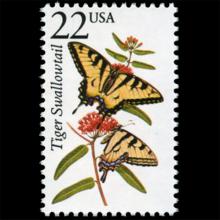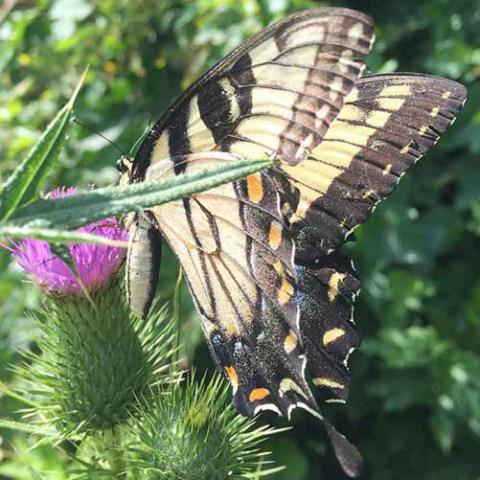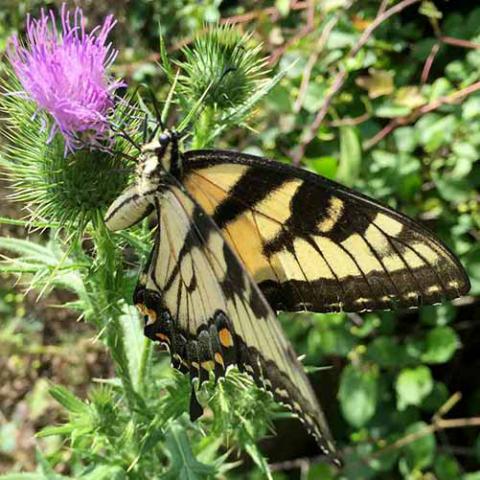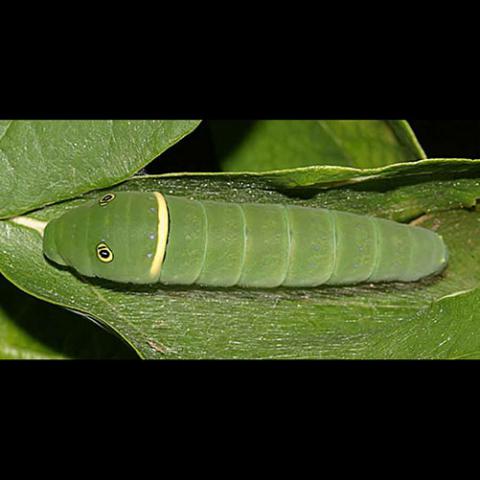NAMES
TAXONOMY
Angola
Issued:
Stamp:
Papilio glaucus
United States
Issued:
Stamp:
Papilio glaucus
Angola
Issued:
Stamp:
Papilio glaucus
United States
Issued:
Stamp:
Papilio glaucus
Angola
Issued:
Stamp:
Papilio glaucus
United States
Issued:
Stamp:
Papilio glaucus
Genus species (Animalia): Papilio glaucus
Papilio glaucus, the eastern tiger swallowtail, is a species of butterfly native to eastern North America. It is one of the most familiar butterflies in the eastern United States, where it is common in many different habitats and travels as far North as Winnipeg Manitoba, Canada. It flies from spring to fall, during which it produces two to three broods. Adults feed on the nectar of many species of flowers, mostly from those of the families Apocynaceae, Asteraceae, and Fabaceae. Papilio glaucus has a wingspan measuring 7.9 to 14 cm (3.1 to 5.5 in). The male is yellow with four black "tiger stripes" on each forewing. Females may be either yellow or black, making them dimorphic. The yellow morph is similar to the male, but with a conspicuous band of blue spots along the hindwing, while the dark morph is almost completely black.
The green eggs are laid singly on plants of the families Magnoliaceae and Rosaceae. Young caterpillars are brown and white; older ones are green with two black, yellow, and blue eyespots on the thorax. The caterpillar will turn brown prior to pupating. It will reach a length of 5.5 cm (2.2 in). The chrysalis varies from a whitish color to dark brown. Hibernation occurs in this stage in locations with cold winter months.
The eastern tiger swallowtail is the state butterfly of Alabama (as well as state mascot), Delaware, Georgia, North Carolina and South Carolina, and is the state insect of Virginia.
Description
The wingspan ranges from 7.9 to 14 cm (3.1 to 5.5 in) with females being the larger sex. Southern individuals are larger than northern ones. Males are yellow with four black "tiger stripes" on each forewing. The outer edge of the forewing is black with a row of yellow spots. The veins are marked with black. The postmedian area of the hindwing is black with yellow spots along the margin. The inner margin of the hindwing has small red and blue spots. The ventral forewing margin has a yellow bar that is broken into spots. This broken bar is present in both sexes, and is used to distinguish Papilio glaucus from its close relatives.
Females are dimorphic. The yellow morph differs from the male in having a blue postmedian area on the dorsal hindwing. In the dark morph, the areas that are normally yellow are replaced with dark gray or black. The bluish postmedian area on the ventral hindwing has one row of orange spots. A shadow of the "tiger stripes" can be seen on the underside of some dark females.
Papilio glaucus is one of a few species of papilionids known to produce gynandromorphs. Most bilateral gynandromorphs are hybrids of Papilio glaucus and Papilio canadensis that are found along hybrid zones. Color mosaics are found in the central part of the species range.
Taxonomy
The first known drawing of a North America butterfly was of an eastern tiger swallowtail. It was drawn by John White in 1587, during Sir Walter Raleigh's third expedition to Virginia. White named his drawing "Mamankanois" which is believed to be a Native American word for "butterfly". This species was later described by Carl Linnaeus in his 10th edition of Systema Naturae in 1758. Some taxonomists place Papilio glaucus, along with the other tiger swallowtails, in the genus Pterourus.
The eastern tiger swallowtail was formerly considered a single species with a vast range into northern Canada and the eastern United States. In 1991, the subspecies Papilio glaucus canadensis was elevated to species level, thus reducing the range of Papilio glaucus to south of Canada. In 2002, another closely related species, Papilio appalachiensis, was described by H. Pavulaan and D. M. Wright from the southern Appalachian Mountains. These two species can be separated from Papilio glaucus by size; Papilio canadensis is smaller and Papilio appalachiensis is larger. These two also have a solid yellow bar along the margin of the ventral forewing. Papilio canadensis females are not dimorphic, and Papilio appalachiensis females are rarely black.
Similar species for the dark Papilio glaucus female include the pipevine swallowtail (Battus philenor), the spicebush swallowtail (Papilio troilus), and the female black swallowtail (Papilio polyxenes). B. philenor differs from the dark morph Papilio glaucus by the row of light-colored spots on each wing margin. Papilio troilus is more greenish, and has two rows of orange spots on the ventral hindwing. Papilio polyxenes is smaller, and the ventral hindwing has two rows of yellow-orange spots.
Distribution and habitat
Papilio glaucus is found in the eastern United States from southern Vermont to Florida west to eastern Texas and the Great Plains. It is common throughout its range, although is rarer in southern Florida and absent from the Florida Keys. In 1932, a single specimen was collected in County Wicklow, Ireland. It is believed to have been an accidental introduction from North America.
Papilio glaucus can be found almost anywhere deciduous forests occur. Common habitats include woodlands, fields, rivers, creeks, roadsides, and gardens. It will stray into urban parks and city yards. Because it has adapted to many different habitats and host plants, P. glaucus is a generalist, and is not considered threatened. Papilio glaucus is considered to be one of the most polyphagous of all swallowtail species. This is likely due to genetic traits and differential detoxification abilities. However, as compared to Papilio canadensis, at the northern overlap between the two species, Papilio glaucus survive very poorly through their first larval instar when settling on a quaking aspen (Populus tremeloides) tree and their survival rate under those conditions are approximately 15%, whereas P. canadensis thrives on this food plant.
Adults are seen from spring to fall, although the exact date varies depending on the location. In the south, they are seen from February to November; in the north, they are seen from May to September. Papilio glaucus produces two broods in the north and three in the south. The first broods yield the smallest adults.
Reference: Wikipedia






